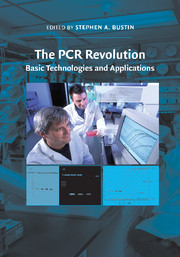Book contents
- Frontmatter
- Contents
- Contributors
- Foreword by Russell Higuchi
- Preface
- I BASIC TECHNOLOGIES
- II APPLICATIONS
- 10 Polymerase chain reaction–based methods for the detection of solid tumor cancer cells for clinical diagnostic and prognostic assays
- 11 Polymerase chain reaction and infectious diseases
- 12 Polymerase chain reaction and respiratory viruses
- 13 Polymerase chain reaction and severe acute respiratory syndrome
- 14 The MMR vaccine, measles virus, and autism – A cautionary tale
- 15 Noninvasive prenatal diagnosis using cell-free fetal nucleic acids in maternal plasma
- 16 Polymerase chain reaction–based analyses of nucleic acids from archival material
- 17 Microarrays and quantitative real-time reverse transcriptase–polymerase chain reaction
- 18 Polymerase chain reaction in the detection of genetic variation
- 19 Polymerase chain reaction: A blessing and a curse for ancient deoxyribonucleic acid research
- Index
- Plate section
- References
11 - Polymerase chain reaction and infectious diseases
Published online by Cambridge University Press: 25 January 2011
- Frontmatter
- Contents
- Contributors
- Foreword by Russell Higuchi
- Preface
- I BASIC TECHNOLOGIES
- II APPLICATIONS
- 10 Polymerase chain reaction–based methods for the detection of solid tumor cancer cells for clinical diagnostic and prognostic assays
- 11 Polymerase chain reaction and infectious diseases
- 12 Polymerase chain reaction and respiratory viruses
- 13 Polymerase chain reaction and severe acute respiratory syndrome
- 14 The MMR vaccine, measles virus, and autism – A cautionary tale
- 15 Noninvasive prenatal diagnosis using cell-free fetal nucleic acids in maternal plasma
- 16 Polymerase chain reaction–based analyses of nucleic acids from archival material
- 17 Microarrays and quantitative real-time reverse transcriptase–polymerase chain reaction
- 18 Polymerase chain reaction in the detection of genetic variation
- 19 Polymerase chain reaction: A blessing and a curse for ancient deoxyribonucleic acid research
- Index
- Plate section
- References
Summary
As in numerous other areas, the comparatively simple technique of polymerase chain reaction (PCR) has revolutionized the field of infectious diseases. Whether this is through sequencing the genomes of key pathogens or developing vaccines by genetic manipulation, PCR-driven molecular biology has stamped its mark on infectious diseases. It is particularly fascinating to consider how PCR has influenced, and continues to influence, disease management and to realize how influential this research technology has become as a practical diagnostic tool.
Its role in this context can be broadly split into diagnosis, epidemiology, and prognostic monitoring. However, before considering the utility of the PCR, it is useful to discuss infectious diseases and the additional considerations required for using PCR for their management.
Infectious diseases can be broadly split into groups corresponding to the causative pathogen: bacterial (tuberculosis [TB], pseudomembranous colitis [PMC], sepsis) and viral (acquired immunodeficiency syndrome [AIDS], hepatitis C, influenza) are two simple groupings. Viral pathogens are the most common causes of infectious diseases worldwide (e.g., common cold with numerous viral causes), with bacterial pathogens often being more serious when they strike. The remaining categories are more complex and include the eukaryotes. A major group are the Protozoa, including the causes of many classical tropical diseases (e.g., malaria and sleeping sickness). The fungal pathogens (Pneumocystis pneumonia [PCP]) are frequently opportunistic, causing infections worldwide in individuals with reduced or impaired immunity.
- Type
- Chapter
- Information
- The PCR RevolutionBasic Technologies and Applications, pp. 173 - 188Publisher: Cambridge University PressPrint publication year: 2009



